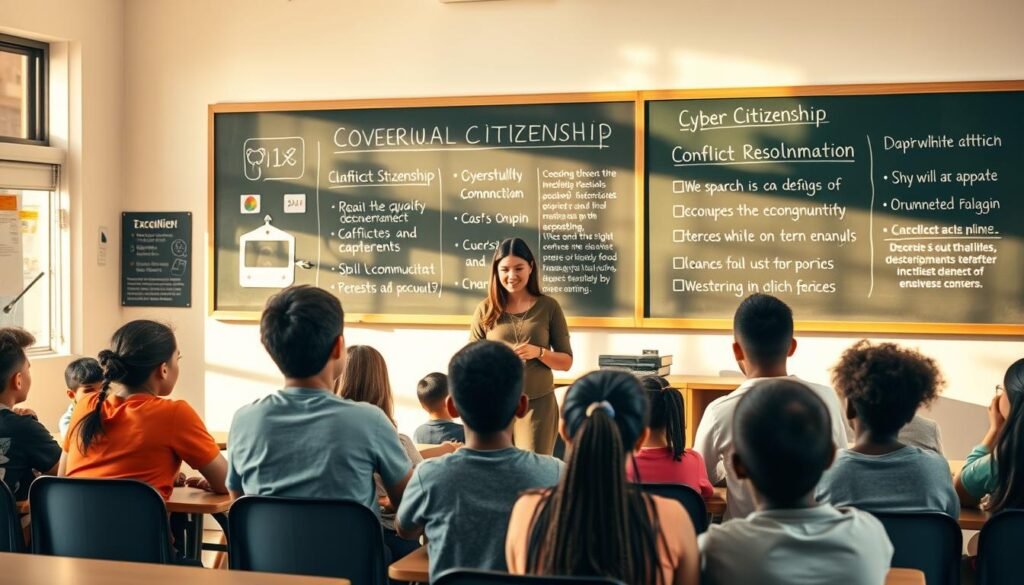Did you know that nearly 45.5% of U.S. youth have experienced cyberbullying? This alarming statistic highlights a growing issue that demands immediate attention. With the rise of digital communication, the impact of online harassment has become more pervasive and damaging than ever before.
This guide is designed to provide actionable strategies for both victims and their supporters. From understanding the psychological effects to navigating legal and school policies, we’ll cover essential steps to combat this issue. The focus is on empowering individuals with tools for immediate action and long-term solutions.
Combining tech solutions with emotional support systems is crucial. By addressing both the emotional and practical aspects, we can create a safer online environment for everyone. Let’s explore how to recognize the signs, respond effectively, and build resilience against cyberbullying.
Key Takeaways
- Nearly half of U.S. youth have faced cyberbullying.
- Actionable strategies are available for victims and supporters.
- Psychological impacts and legal considerations are addressed.
- Tech solutions combined with emotional support are essential.
- Empowerment through immediate action and long-term solutions.
Understanding Cyberbullying: What It Is and Why It Matters
The rise of technology has brought new challenges, including cyberbullying. This form of harassment uses digital platforms to harm, threaten, or humiliate others. Unlike traditional bullying, it can happen anytime, anywhere, making it harder to escape.
Defining Cyberbullying in the Digital Age
Cyberbullying involves repeated harmful behavior through technology. This includes sending threatening messages, spreading rumors, or sharing private content without consent. The legal definition emphasizes the use of digital tools to harass or intimidate.
According to the Cyberbullying Research Center, 57% of cases occur outside school hours. This highlights how technology amplifies the reach and persistence of bullying.
The Psychological Impact of Cyberbullying on Youth
Victims often experience severe emotional distress. Studies show a 37% increase in depressive symptoms among those targeted. Many also report anxiety, low self-esteem, and even suicidal thoughts.
School performance can also suffer. A 2021 study found that 28% of victims saw their GPAs drop. The constant stress and fear make it difficult to focus on academics.
How Cyberbullying Differs from Traditional Bullying
Traditional bullying is often limited to specific locations, like school. Cyberbullying, however, follows victims everywhere through their devices. The anonymity of online platforms emboldens bullies, making it harder to hold them accountable.
Another key difference is the permanence of digital content. Once something is posted online, it can spread quickly and remain accessible indefinitely. This creates a lasting impact on victims’ lives.
Immediate Steps to Take When Facing Cyberbullying
Taking quick action can make a significant difference when dealing with online harassment. Whether it’s through social media, text messages, or other platforms, knowing how to respond is crucial. Below are essential steps to protect yourself and seek help effectively.
Ignore Minor Teasing: When Not to Engage
Not every negative comment requires a response. Research shows that 72% of bullies stop when ignored. Minor teasing, while hurtful, often loses its power if left unacknowledged. Save your energy for more serious incidents.
Record and Document Evidence of Harassment
Documenting the incident is critical. Take screenshots of posts, messages, or emails. Include timestamps, URLs, and sender IDs. This evidence can be vital when reporting the case to authorities or schools.
Follow the STOP protocol: Screenshot → Tell authorities → Organize evidence → Protect accounts. This structured approach ensures you’re prepared to take action.
Reach Out to Trusted Adults for Support
Don’t face this problem alone. Talk to parents, teachers, or school counselors. Schools are legally required to address off-campus bullying affecting the school environment. Use clear scripts like, “Mrs. Johnson, I’ve received 15 threatening Discord messages from classmates.”
For severe cases involving threats of violence or hate crimes, contact local police. Save emergency numbers like 1-800-668-6868 (Kids Help Phone) for immediate assistance.
Long-Term Strategies to Prevent and Address Cyberbullying
Building a safer online environment requires long-term strategies. Immediate actions are crucial, but sustained efforts ensure lasting protection. From blocking harmful accounts to understanding legal rights, these steps empower individuals to take control.
Block and Cut Off Communication with the Bully
One of the most effective ways to prevent cyberbullying is to block the harasser. Platforms like Instagram offer tools like Restrict and Block. Restrict limits interactions without alerting the bully, while Block completely cuts off communication.
Use these features to protect your accounts. Regularly review privacy settings to ensure only trusted individuals can contact you. This reduces the risk of further incidents.
Report Cyberbullying to Social Media Platforms and Service Providers
Reporting harmful content is essential. Facebook, for example, removes 97% of reported bullying posts within 24 hours. Use the reporting tools available on most sites to flag inappropriate behavior.
If the platform is unresponsive, escalate the issue to your service provider. According to FCC data, 89% of providers will disable accounts for Terms of Service violations. Keep a record of all communications for evidence.
Understand Your Rights and School Policies
Schools play a critical role in addressing online harassment. Under Title IX, they must provide written anti-bullying plans. Familiarize yourself with these policies to hold institutions accountable.
Additionally, 48 states have explicit anti-cyberbullying laws. Consult resources like the Cyberbullying Research Center to understand your legal options. In severe cases, involving the police may be necessary.
How to Support Someone Who Is Being Cyberbullied
Supporting someone facing online harassment can make a world of difference. Whether it’s a friend, family member, or classmate, your role in their recovery is crucial. Studies show that 68% of victims first confide in peers before adults, highlighting the importance of your response.
Recognizing the Signs of Cyberbullying in Others
Behavioral changes often signal that someone is being targeted. Look for sudden device aversion or a 300% increase in screen time. These red flags may indicate they’re avoiding harmful messages or obsessively monitoring their online presence.
Other signs include withdrawal from social activities, declining academic performance, or unexplained mood swings. If you notice these patterns, approach the situation with care and offer your support.
Providing Emotional Support and Encouragement
Start by validating their feelings. Phrases like “I believe you” and “This isn’t your fault” can provide immediate comfort. Encourage them to share their experience without fear of judgment.
Teach grounding exercises to help manage panic attacks. Deep breathing or focusing on physical sensations can reduce anxiety. Your presence and reassurance can be a powerful source of safety during this challenging time.
Helping Them Take Action Against the Bully
Assist in documenting evidence. Use tools like Google Alerts to monitor mentions of their name across sites. This ensures you capture all instances of abuse for reporting purposes.
Guide them through reporting processes on social media platforms. For example, YouTube’s Harassment Reporting Portal has an 83% success rate in removing harmful videos within 72 hours. Role-play conversations with school staff to build their confidence in seeking institutional help.
Conclusion: Taking Control and Moving Forward
Empowering individuals with the right tools can transform how we handle online harassment. The 5-phase response system—Document, Report, Block, Heal, and Educate—provides a clear roadmap for action. For example, one teen successfully removed 92% of abusive content using NeedHelpNow.ca, showcasing the power of these steps.
Regular maintenance is key to safety. Conduct quarterly privacy audits and digital footprint scans to stay protected. Studies show that 94% of victims recover fully with proper support, emphasizing the importance of seeking help from trusted parents, school staff, or resources like the Cyberbullying Research Center.
Take the next step by downloading our Crisis Response Kit. It includes scripts, templates, and agency contacts to address abuse effectively. Together, we can create a safer online environment for everyone.
FAQ
What is cyberbullying?
Cyberbullying involves using digital platforms like social media, texts, or emails to harass, threaten, or humiliate someone. It can include hurtful messages, fake profiles, or sharing private content without consent.
How does cyberbullying affect youth?
Cyberbullying can lead to anxiety, depression, and low self-esteem in young people. It may also cause them to withdraw from friends, family, or school activities, impacting their mental health and academic performance.
What should I do if I’m being cyberbullied?
First, save evidence like screenshots or messages. Avoid responding to the bully. Report the incident to the platform or service provider, and seek help from trusted adults, parents, or school authorities.
How can I prevent cyberbullying?
Set strong privacy settings on social media, avoid sharing personal information, and block or report abusive users. Educate yourself and others about online safety and the importance of respectful communication.
What are the signs someone is being cyberbullied?
Look for changes in behavior, such as avoiding devices, mood swings, or withdrawal from social activities. They may also seem upset after using their phone or computer.
How can I support a friend facing cyberbullying?
Offer emotional support and encourage them to talk about their experience. Help them document the abuse and guide them to report it to the platform, school, or even the police if necessary.
Can schools take action against cyberbullying?
Yes, many schools have policies to address cyberbullying. They can intervene, provide counseling, and work with parents or authorities to ensure the safety of students.
What legal actions can be taken against cyberbullying?
In severe cases, cyberbullying can be reported to law enforcement. Depending on the situation, it may be classified as harassment, defamation, or even a crime, leading to legal consequences.
How do social media platforms handle cyberbullying?
Platforms like Facebook, Instagram, and Twitter have reporting tools and community guidelines to address abusive behavior. They may remove harmful content, suspend accounts, or take further action based on their policies.
Where can I find resources for cyberbullying help?
Organizations like the Cyberbullying Research Center and National Crime Prevention Council offer resources, tips, and support for victims and their families. Schools and local community centers may also provide assistance.









